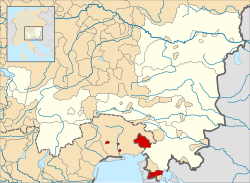
Back Comtat de Gorízia Catalan Grevskabet Görz Danish Grafschaft Görz German Condado de Goricia Spanish Görzi krahvkond Estonian Comté de Goritz French Goriška Croatian Görzi grófság Hungarian Grafschaft Gorizia ID Contea di Gorizia Italian
This article has multiple issues. Please help improve it or discuss these issues on the talk page. (Learn how and when to remove these template messages)
|
(Princely) County of Gorizia | |||||||||
|---|---|---|---|---|---|---|---|---|---|
| c. 1117–1500 | |||||||||
 County of Gorizia (red) at the time of the Hohenstaufen Emperors (circa 1250); the highlighted area roughly corresponds with the later Austrian Circle, which is provided for context only. | |||||||||
 Map of the Habsburg hereditary lands around 1526. The County of Gorizia in yellow. | |||||||||
| Status | State of the Holy Roman Empire | ||||||||
| Capital | |||||||||
| Official languages | Latin | ||||||||
| Common languages | |||||||||
| Religion | Roman Catholicism | ||||||||
| Government | County | ||||||||
| Count | |||||||||
• 1122–1142 | Meinhard I | ||||||||
• 1454–1500 | Leonhard | ||||||||
| Historical era | Middle Ages | ||||||||
• Meinhard, Count of Gorizia | c. 1117 | ||||||||
• Meinhard III inherited Tyrol | 1253 | ||||||||
• Raised to principality | 1365 | ||||||||
• Bequeathed to House of Habsburg | 1500 | ||||||||
• Joined Austrian Circle | 1512 | ||||||||
• Reunited with Gradisca | 1500 | ||||||||
| Currency | Gorizian Denar | ||||||||
| |||||||||
The County of Gorizia (Italian: Contea di Gorizia, German: Grafschaft Görz, Slovene: Goriška grofija, Friulian: Contee di Gurize), from 1365 Princely County of Gorizia, was a State of the Holy Roman Empire. Originally mediate Vogts of the Patriarchs of Aquileia, the Counts of Gorizia (Meinhardiner) ruled over several fiefs in the area of Lienz and in the Friuli region of northeastern Italy with their residence at Gorizia (Görz).
In 1253 the Counts of Gorizia inherited the County of Tyrol, from 1271 onwards ruled by the Gorizia-Tyrol branch which became extinct in the male line in 1335. The younger line ruled the comital lands of Gorizia and Lienz until its extinction in 1500, whereafter the estates were finally acquired by the Austrian House of Habsburg.

